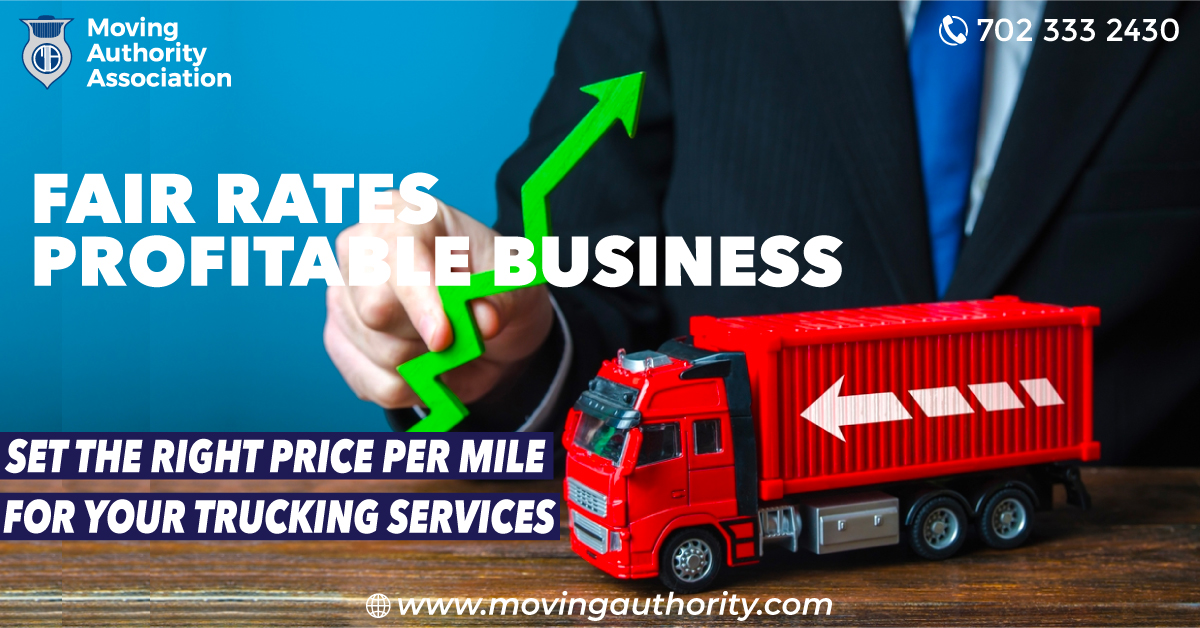
Fair Rates, Profitable Business, How To Set The Right Price Per Mile For Your Trucking Services
How To Set The Right Price Per Mile For Your Trucking Services
Setting the right price per mile is a critical aspect of running a successful trucking business. In the highly competitive and dynamic trucking industry, fair rates that balance profitability and customer value are essential for sustainable growth. Learn more about Starting a Trucking Company. Whether you are an owner-operator or manage a fleet, understanding how to price your trucking services effectively can make a significant difference in your bottom line.
In this article, we will explore the art and science of pricing in the trucking industry. Acquiring Success, We'll talk about the different cost factors that influence the price per mile, analyze market conditions to make informed pricing decisions, and discuss different pricing strategies to maximize profitability. By the end of this article, you will have a comprehensive understanding of how to set the right price per mile for your trucking services, ensuring fair rates that not only cover your costs but also drive profitability and position your business for long-term success.
Whether you're a newcomer to the trucking industry or an experienced professional seeking to refine your pricing strategy, this article will provide you with valuable insights and practical tips to help you navigate the complex world of pricing in the trucking industry. Do you Want to know the BOC-3 Filing? So let's dive in and discover the key factors and strategies to achieve fair rates and a profitable trucking business.
Factors That Influence Price-Per-Mile Calculation
Setting the right price per mile requires a thorough understanding of the factors that influence the cost of trucking services. FMCSA BOC 3 Filing. Considering these factors, you can ensure that your pricing reflects the expenses incurred and helps you maintain profitability. Here are some key factors to consider when calculating the price per mile for your trucking services:
The first factor to consider is your operating costs, encompassing fixed and variable expenses. Learn more about Biennial Update. Fixed costs include items like insurance, permits, and licenses, while variable costs include fuel, maintenance, and driver wages. By accurately accounting for these costs, you can determine the minimum rate per mile required to cover your expenses.
Another important factor to consider is the depreciation of your equipment. Trucks and trailers have a limited lifespan, and factoring in depreciation helps you allocate the costs over their useful life. By including a portion of the equipment's value in your price per mile, you can ensure you are setting aside funds for future equipment replacement.
Market conditions play a significant role in determining the price per mile. Supply and demand dynamics, industry trends, and customer expectations can influence the rates you can charge. Conducting market research and monitoring industry benchmarks can help you gauge the prevailing rates and adjust your pricing strategy accordingly.
The characteristics of the freight you haul can also impact your pricing. Weight, volume, fragility, and special handling requirements can influence the time, effort, and resources required to transport the goods. Read more about the Broker Freight Package. Consider these factors when determining your price per mile to ensure you adequately compensate for the unique demands of each load.
By carefully analyzing these factors and incorporating them into your pricing calculations, you can set a fair and competitive price per mile that accurately reflects the costs of providing your trucking services. Remember, a thorough understanding of your expenses and market dynamics is critical to ensuring profitability and long-term success in the trucking industry.
Understanding Supply And Demand Dynamics In The Trucking Market
Supply and demand dynamics play a crucial role in shaping the trucking industry and directly impact the rates and profitability of trucking services. Understanding these dynamics allows you to make informed pricing decisions and position your business for success. Here are some key aspects to consider when analyzing supply and demand in the trucking market:
Capacity Constraints: The balance between the number of available trucks and the volume of freight to be transported creates capacity constraints in the market. When excess capacity exists, such as during economic downturns or periods of low demand, competition among carriers intensifies, leading to lower rates. Do you want to know Broker Mover Package information? On the other hand, when capacity is tight due to increased demand or supply chain disruptions, carriers have more negotiating power and can command higher rates.
Seasonal Fluctuations: The trucking market experiences seasonal fluctuations that can impact supply and demand. For example, the demand for transporting consumer goods tends to surge during peak shopping seasons like the holidays, leading to increased rates. Certain industries may experience slower demand during specific months, affecting pricing.MC Trucking: Exploring the Benefits and Requirements. Understanding these seasonal patterns helps you anticipate changes in demand and adjust your pricing strategy accordingly.
Economic Factors: Economic conditions and trends also influence supply and demand in the trucking market. Factors like GDP growth, industrial output, and consumer spending impact the need for transportation services. During periods of economic expansion, increased business activity and consumer demand drive up freight volumes, leading to higher rates. Conversely, economic downturns can result in reduced demand and more competitive pricing.
Industry Trends: Stay abreast of industry trends and developments to gain insights into supply and demand dynamics. Do you want to know the CA Number? Pay attention to factors such as emerging technologies, regulation changes, and consumer preferences shifts. For example, the rise of e-commerce has increased the demand for last-mile delivery services, creating new opportunities for carriers. You can identify niche markets and adjust your pricing strategy to meet evolving customer needs by staying informed.
By closely monitoring supply and demand dynamics in the trucking market, you can position your business strategically and make informed pricing decisions. Understanding when capacity is tight or high demand enables you to negotiate favorable rates and maximize profitability. MC Truck. Stay vigilant, adapt to market conditions, and leverage your knowledge to gain a competitive edge in the industry.
Market Research To Identify Industry Trends And Competitors' Pricing
Conducting thorough market research is essential for trucking businesses looking to set the right price per mile and stay competitive in the industry. Gathering valuable insights about industry trends and competitors' pricing strategies enables you to make informed decisions and position your services effectively. Here are key steps to consider when conducting market research:
Start by conducting a comprehensive analysis of the trucking industry. Stay informed about market trends, technological advancements, and regulatory changes that impact the transportation sector. Know what is a Carrier Agreement. Monitor industry publications, attend conferences, and join professional networks to stay current. This research will help you understand the current landscape, anticipate future developments, and adjust your pricing strategy accordingly.
Study your competitors' pricing strategies to gain insights into their market positioning and pricing levels. Understanding MC Numbers In The Trucking Industry. Analyze their pricing structures, service offerings, and target markets. This information will provide valuable benchmarks and help you identify competitive advantages and areas for improvement. Remember that direct competitors may not be the only sources of competition; consider indirect competitors and emerging players in the market.
Understand your target customers' needs, preferences, and price sensitivity. Conduct surveys, interviews, and focus groups to gather customer feedback. Identify what factors they value most when selecting a trucking service and assess their price expectations. This customer-centric approach will help you tailor your pricing strategy to meet their specific requirements and deliver value.
Utilize pricing intelligence tools and resources to gather data on market rates, price trends, and customer demand. Read more about the Claims Package. These tools can provide you with insights into regional pricing variations, seasonal fluctuations, and industry benchmarks. By leveraging this information, you can align your pricing strategy with the market and ensure your rates are competitive yet profitable.
By conducting thorough market research, you can understand industry trends, competitors' pricing strategies, and customer preferences. BOC 3 Registration. This knowledge empowers you to make informed pricing decisions, differentiate your services, and effectively position your business in the market. Remember that market research should be an ongoing process to adapt to changing dynamics and maintain a competitive edge.
Effective Pricing Strategies:
Cost-Plus Pricing Method
The Cost-Plus Pricing Method is a straightforward approach to setting prices that considers the total cost of providing a service, along with an added markup to ensure profitability. With this method, you calculate all the costs associated with operating your trucking business, such as fuel, maintenance, insurance, driver wages, and administrative expenses. Learn more about DOT Number Deactivation. Once you have determined the total costs, you add a predetermined percentage or fixed amount as the profit margin. This pricing method allows you to ensure that your expenses are covered and provides a clear structure for determining your prices. It is a practical approach for small businesses and those who want to understand their expenses and profit margins clearly.
Value-Based Pricing Method
The Value-Based Pricing Method is a pricing strategy that focuses on the perceived value of your trucking services to customers. Rather than solely considering your costs or competitors' prices, this method takes into account the unique value you provide to your customers. It involves understanding your customers' needs, preferences, and the benefits they receive from your services. By aligning your pricing with the value customers perceive, you can capture your business's fair share of that value. This approach allows you to differentiate yourself in the market and potentially charge higher prices for your specialized services or exceptional customer experience. The Value-Based Pricing Method emphasizes the importance of understanding and delivering value to your customers while ensuring your pricing aligns with that value.
Competitor-Based Pricing Method
The Competitor-Based Pricing Method is a pricing strategy that involves setting prices based on what your competitors are charging for similar trucking services. With this approach, you analyze your competitors' pricing strategies and position your prices accordingly. It aims to stay competitive in the market by either matching your competitors' prices or offering lower prices to attract customers. By monitoring the pricing landscape and understanding the value proposition of your competitors, you can make informed decisions about your own pricing. However, it's essential to consider other factors, such as your costs and value proposition, to ensure your pricing strategy remains sustainable and profitable in the long run. The Competitor-Based Pricing Method provides insights into the pricing practices of your competitors and helps you find a balance between competitiveness and profitability in the market.
Pricing For Profitability And Growth
Pricing for Profitability and Growth is a pricing strategy that focuses on setting prices that not only ensure profitability but also support the long-term growth of your trucking business. It involves finding the right balance between pricing to generate sufficient profit margins and investing those profits back into the business for expansion and development. Do you want to know Dot Authority? This strategy considers costs, market dynamics, and growth objectives to determine the optimal pricing that maximizes current profitability and future business growth. By aligning your pricing with your profitability goals and reinvesting in areas such as equipment, technology, and talent, you can position your trucking business for sustainable success and long-term growth.
Monitoring And Adjusting Pricing Strategies Over Time
Monitoring and adjusting pricing strategies over time is essential for trucking businesses to maintain competitiveness and profitability. It involves regularly evaluating the effectiveness of your pricing strategies and making necessary adjustments based on market conditions, customer preferences, and business goals. Learn more about Movers Association Membership. By monitoring key performance indicators such as revenue, profit margins, and customer satisfaction, you can gain valuable insights into the performance of your pricing strategies. This allows you to identify areas of improvement, such as pricing inefficiencies or opportunities for price optimization. Adjustments can include price increases or decreases, discounts, promotions, or changes in pricing structures. By staying proactive and responsive to market dynamics, you can ensure that your pricing strategies remain aligned with your business objectives and continue to drive profitability and growth over time.
Implementing effective pricing strategies is critical to achieving long-term success in the trucking industry. Setting the right price per mile for your services ensures that your business remains competitive, profitable, and sustainable. It may take time and effort to analyze market conditions, understand cost factors, and evaluate pricing methods, but the rewards are well worth it. Do you want to know about the Drug and Alcohol Program? Effective pricing allows you to cover your costs and generate profits, and enable you to invest in your business, expand your operations, and attract and retain valuable customers. Remember, pricing is not a one-time decision but an ongoing process requiring monitoring, adjusting, and adapting to changing market conditions. So, take the initiative, implement sound pricing strategies, and position your trucking business for long-term success in a dynamic and competitive industry.





